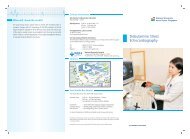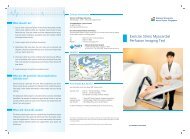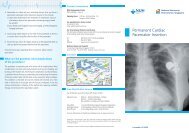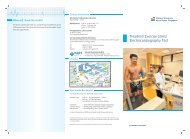Transcatheter Aortic Valve Implantation - nuhcs
Transcatheter Aortic Valve Implantation - nuhcs
Transcatheter Aortic Valve Implantation - nuhcs
Create successful ePaper yourself
Turn your PDF publications into a flip-book with our unique Google optimized e-Paper software.
Why is <strong>Transcatheter</strong> <strong>Aortic</strong> <strong>Valve</strong><strong>Implantation</strong> (TAVI) needed?<strong>Transcatheter</strong> <strong>Aortic</strong> <strong>Valve</strong> <strong>Implantation</strong> (TAVI) is used to treat severe <strong>Aortic</strong>Stenosis, a condition in which the aortic valve becomes narrowed, obstructingthe outflow of blood from the heart and thereby requiring the heart to workharder to pump blood around the body.TAVI is a procedure performed using the Edwards Sapien <strong>Transcatheter</strong>Heart <strong>Valve</strong> (THV), an artificial heart valve designed to be inserted into yourheart so that it holds open and replaces your diseased aortic valve. It consistsof a metal stent (made of steel or cobalt-chromium) which secures thedevice in its intended position inside your own valve, and valve leaflets(made of biological material derived from cows) to direct the flow of bloodout of your heart.TAVI now offers effective treatment to patients who are at high risk forconventional open heart surgery. It is also intended to prevent furtherdamage to the heart from <strong>Aortic</strong> Stenosis and to prolong life, which medicaltherapy cannot do.Normal <strong>Aortic</strong> <strong>Valve</strong>Normal <strong>Aortic</strong> StenosisOpen Closed Open ClosedWhat can I expect before the procedure?Before the procedure, you will undergo routine investigations to evaluatewhether TAVI is possible and which of the two techniques for TAVI(Transfemoral or Transapical route) is most appropriate for you. Theinvestigations will also and to identify any other considerations that needto be addressed for your treatment. The investigations include:– A physical examination– Angiogram– Blood tests– Chest X-ray– CT Scans– ElectrocardiogramWhether you are selected to undergo the transfemoral or the transapicalapproach, this procedure will be performed under general anesthesia. Asthe heart is not opened to expose the aortic valve, fluoroscopy (X-rays) andtransesophageal echocardiography (ultrasound) are used to visualize theheart and THV, and to guide the insertion of the THV. The duration of X-rayexposure that you will receive will normally be not more than 30 minutes,the normal length of time it takes for a coronary artery procedure in thecardiac catheterization laboratory.Transfemoral TAVIThe transfemoral device is designed to be implanted through the bloodvessel (femoral artery) in your leg. Due to the size of the catheter (hollowtube) being placed in your artery for this approach, your doctors will evaluatethe angiograms and/or CT scans to ensure your blood vessels are big enoughfor this device. Prior to implantation, the THV is “crimped” (carefullycompressed to a size that fits inside your femoral artery) using a specificallydesigned crimping device. The crimped THV is mounted onto a balloondelivery catheter, a special device which is used to carry the THV up to theheart and directly into your aortic valve. The valve is then expanded usinga balloon to fit inside your stenotic aortic valve, holding your own valveopen permanently. Once the valve is in position and the delivery system isremoved from your femoral artery, the artery is closed using a special suturedevice designed for this purpose. After the procedure, you will be transferredto the Coronary Care Unit (CCU).Transapical TAVIThe transapical approach is used for patients whose arteries are too smallor too diseased for the transfemoral approach.Figure 1: Balloon inflation of the<strong>Transcatheter</strong> <strong>Valve</strong>Figure 2: Final result.The delivery system for this approach is designed for THV implantationthrough the tip (apex) of your heart, which is reached through a smallincision made between the ribs just below the left nipple. The crimpedTHV and delivery system is inserted through the apex of your heart directlyinto your stenotic aortic valve. The valve is then expanded using a balloonto fit across your stenotic aortic valve, holding it open permanently. Afterthe procedure you will be transferred to the Cardiothoracic Intensive CareUnit (CTICU).What happens after the procedure?After the TAVI procedure, you will be transferred to either the CCU wardor the CTICU ward for close monitoring. When you are first transferred,you may be under sedation and on ventilatory support. Over the courseof the next 24 hours, you will be awakened from the sedation and allowedto breathe on your own with the ventilation tube removed. You will remainin the CCU or CTICU ward until your doctor feels that you can be transferredto a regular hospital ward, where you will continue to be monitored untilyour discharge from the hospital, usually within 5 – 7 days.You will be given blood thinning medications such as aspirin and clopidogrel(Plavix). You should continue taking these or other blood thinners for 6months after the procedure and aspirin for life (as recommended forroutine stenting of coronary blood vessels and any replacement heartvalve). The following routine checks will be completed while you are inhospital:– A physical examination– Chest X-ray– Daily electrocardiogram (ECG)– Standard blood tests– Transthoracic echocardiogram (TTE)Thereafter, you will be required to see your doctor in the clinic after 30days, 6 months, 12 months, and then once a year. The routine checks suchas echocardiography are repeated at your first and subsequent outpatientfollow-ups.
















